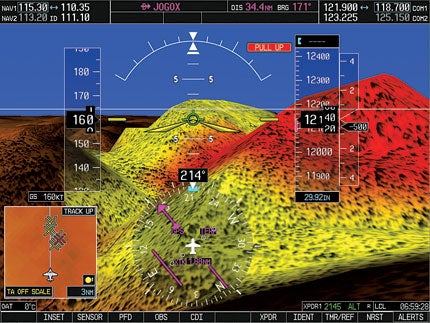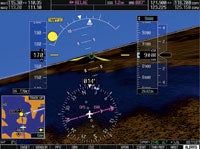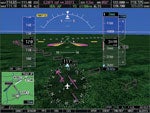Tech Talk: Garmin‘s Synthetic Vision Technology
It replicates what you see outside the cockpit on a clear day
Â If there ever was a cross between a computer game and the real world, it was laid out on the panel before me. I was at the 2008 Sun 'n Fun Fly-In in Lakeland, Fla., flying what was, at the time, the world's only general aviation synthetic vision system installed in an airplane. This one was part of a Garmin G1000 flat-panel display mounted in a Diamond DA40 Star. Garmin's Synthetic Vision Technology (SVT) was recently granted an STC to integrate with the G1000's PFD. Because Diamond was the launch customer on the initial G1000 avionics suite offering five years ago, it's perhaps appropriate that the first unit was installed in a Diamond Star.
If there ever was a cross between a computer game and the real world, it was laid out on the panel before me. I was at the 2008 Sun 'n Fun Fly-In in Lakeland, Fla., flying what was, at the time, the world's only general aviation synthetic vision system installed in an airplane. This one was part of a Garmin G1000 flat-panel display mounted in a Diamond DA40 Star. Garmin's Synthetic Vision Technology (SVT) was recently granted an STC to integrate with the G1000's PFD. Because Diamond was the launch customer on the initial G1000 avionics suite offering five years ago, it's perhaps appropriate that the first unit was installed in a Diamond Star.
Contrary to what you might imagine, synthetic vision is far from new. It has been around in various forms for more than 30 years. As with so many other exotic avionics products, which demand massive injections of money to survive development, what the military called pictorial format avionics was first explored by NASA and the USAF in the 1970s. The Air Force/Navy/Marine Corps mission is so critical, often with lives in the balance, that a reliable method of completing the flight and putting weapons on target is essential, no matter how bad the weather.
 |
| Garmin's SVT depicts terrain coded according to threat level (top). It offers HITS guidance (above) and alerts pilots to real-time traffic readouts (below). |
The technology's cost has extended the time it would normally take to trickle down to general aviation. A decade ago, during the AOPA Convention in Ft. Lauderdale, Fla., I flew one of the early prototype Sierra Flight System---now Chelton---synthetic vision systems with designer Gordon Pratt in his Cessna Turbo Centurion. We flew from Ft. Lauderdale up to Vero Beach in the airplane and made a simulated zero-zero approach to Vero. With Gordon in the right seat as my security blanket, I stayed under the hood for the entire flight---takeoff, en route, approach and landing---using the system's visual cues. I managed to land the airplane without breaking anything, barely. It wasn't pretty, but it demonstrated what was possible.
Today, Garmin's SVT offers synthetic vision fully matured and capable of reliable and consistent precision. It's important to differentiate synthetic vision from other technologies (such as infrared) that actually see through clouds. Synthetic vision is a kind of real-world, three-dimensional IFR simulator, only equally applicable to VFR. It's a kind of artificial representation of the terrain and obstacles ahead. The system could be especially valuable in night displays, VFR or IFR. Land, water and sky are clearly differentiated with shading, colors and textures similar to those used on the company's moving-map display appearing on the MFD.
Garmin's SVT receives its cues from a number of sources. In combination with a 12-channel GPS sensor that pinpoints the airplane's position in three dimensions, the system employs one of aviation's most comprehensive databases. Working through an image-generator computer and a display, the system constructs a simulated image of the surrounding ground references. By tying a TCAS or TIS system to the unit, you can even watch real-time readouts of traffic in the "sky" on the display, with the traffic represented as symbols that move across the screen and grow larger or smaller as they approach or recede.
The XGA display (1024 x 768 pixels) is bright and easily readable in virtually any light, with no tendency to wash out in bright sun. The viewing angle is also good, so both copilot and pilot have equal visibility of the display. In other words, outside influences like weather and night have no effect on the display.
 Ground obstacles, such as towers or tall buildings, are displayed in colors from yellow to red, depending on the threat level. During my short demo flight in Florida, we had a graphic example of the system's obstacle-detection capability. There are five large radio/TV towers southwest of Lakeland, several reaching above 1,500 feet, and we flew directly between two of them, watching the display read out their relative position and threat indication while watching the real towers drift by left and right. The display was so accurate, it would have been easy to avoid the towers, even if our eyes stayed inside the cockpit the whole time. Airports show up in the display as they would in the real world, complete with the appropriate runway orientation and the airport ID suspended above them. Should you descend closer to ground level, the ground display below will shade to yellow, then red, as you lose altitude. Voice alerts are available for all G1000 systems enabled with TAWS-B.
Ground obstacles, such as towers or tall buildings, are displayed in colors from yellow to red, depending on the threat level. During my short demo flight in Florida, we had a graphic example of the system's obstacle-detection capability. There are five large radio/TV towers southwest of Lakeland, several reaching above 1,500 feet, and we flew directly between two of them, watching the display read out their relative position and threat indication while watching the real towers drift by left and right. The display was so accurate, it would have been easy to avoid the towers, even if our eyes stayed inside the cockpit the whole time. Airports show up in the display as they would in the real world, complete with the appropriate runway orientation and the airport ID suspended above them. Should you descend closer to ground level, the ground display below will shade to yellow, then red, as you lose altitude. Voice alerts are available for all G1000 systems enabled with TAWS-B.
Garmin's synthetic vision also includes Highway In The Sky (HITS) guidance, what Garmin prefers to call "Pathways." This creates a series of rectangular boxes that highlight a simulated highway in the sky for your flight. If you're off track---left or right, above or below---it's easy to see the proper intercept. Once you're locked inside the recommended track, the boxes move toward you, enlarge and disappear as you fly through them.
Pathways can lead you through the sky during the en route portion, key your descent during a Vnav procedure and guide you on a GPS, VOR or ILS approach to your destination. Normal IFR minimums will still apply, but it's conceivable that you could fly the airplane down to the ground with no outside references.
Diamond Aircraft, the first company to embrace the Garmin G1000 several years ago, is offering synthetic vision as a $9,995 option. It's such innovative technology, Cessna has embraced it on all its G1000 models and will also offer the system on the Citation Mustang. You can expect to see it soon on Piper/Beech/Mooney products as well. For more information, contact Garmin at (800) 800-1020 or www.garmin.com.

Subscribe to Our Newsletter
Get the latest Plane & Pilot Magazine stories delivered directly to your inbox





